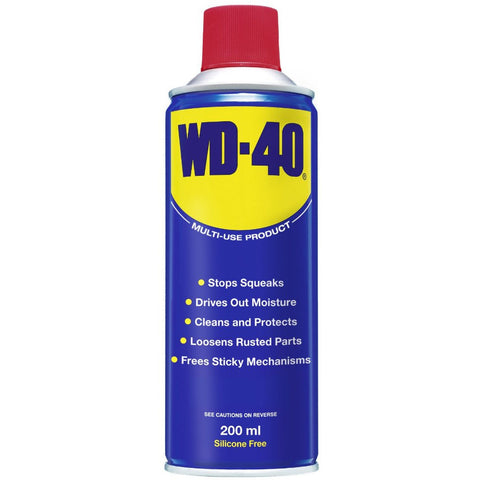
WD-40, known for its versatility beyond just lubrication, is a handy solution for various household tasks in every room. From the kitchen to the garage, WD-40 can be utilized to solve a wide range of everyday problems and maintenance challenges. This article explores the top uses of WD-40 for each room in the house, providing practical tips and techniques for maximizing its effectiveness.
Introduction to WD-40 in Household Applications
Originally formulated to displace water and prevent corrosion, WD-40 has evolved into a multipurpose product widely used for lubrication, cleaning, and protection. Its ability to penetrate and loosen rust makes it a valuable tool in household maintenance.
Kitchen
1. Silencing Squeaky Cabinet Doors
Squeaky cabinet doors can disrupt the tranquility of a kitchen. WD40 can quickly silence these noisy hinges, ensuring smooth and quiet operation.
- How to Use:
- Spray WD-40 directly onto the hinge pivot points and moving parts.
- Open and close the cabinet door several times to distribute WD-40.
- Wipe away any excess WD-40 with a cloth.
2. Removing Grease and Grime from Stove Tops
Stove tops can accumulate grease and grime over time. WD-40 can effectively break down these residues, making them easier to clean.
- How to Use:
- Spray WD-40 onto the greasy areas of the stove top.
- Let it sit for a few minutes to penetrate the grease.
- Wipe clean with a cloth or sponge.
Bathroom
3. Preventing Rust on Shower Heads
Shower heads are prone to rust due to constant exposure to water. WD-40 can be applied to prevent rust formation and ensure optimal water flow.
- How to Use:
- Clean the shower head to remove any existing rust.
- Spray WD-40 onto the shower head and wipe off excess with a cloth.
- Let it dry before using the shower.
4. Cleaning and Polishing Faucets
Faucets can develop water spots and lose their shine over time. WD-40 can be used to clean and polish faucet surfaces, restoring their luster.
- How to Use:
- Spray WD-40 onto a clean cloth.
- Wipe the faucet surfaces to remove water spots and dirt.
- Buff with a dry cloth for a polished finish.
Bedroom
5. Quieting Noisy Door Hinges
Squeaky bedroom door hinges can disturb sleep and peace. WD-40’s lubricating properties can silence these hinges for undisturbed sleep.
- How to Use:
- Apply WD-40 directly onto the hinge pins and moving parts.
- Open and close the door several times to distribute WD-40.
- Wipe away any excess WD-40 with a cloth.
6. Lubricating Drawer Tracks
Drawer tracks in dressers or nightstands can become sticky over time. WD-40 can lubricate these tracks, ensuring smooth opening and closing of drawers.
- How to Use:
- Spray WD-40 along the length of the drawer tracks.
- Slide the drawer in and out several times to distribute WD-40.
- Wipe away excess WD-40 with a cloth.
Living Room
7. Removing Gum and Sticker Residue from Furniture
Gum or sticker residue on furniture can be challenging to remove. WD-40 can dissolve these substances without damaging the furniture’s finish.
- How to Use:
- Spray WD-40 onto the gum or sticker residue.
- Let it sit for a few minutes to penetrate.
- Gently wipe away the residue with a cloth.
8. Protecting and Cleaning Leather Furniture
WD-40 can be used to clean and protect leather furniture, keeping it supple and free from cracks.
- How to Use:
- Spray WD-40 onto a cloth.
- Gently rub the cloth onto the leather furniture to clean and protect.
- Buff with a dry cloth to maintain shine.
Garage or Workshop
9. Loosening Rusty Bolts and Nuts
Rusty bolts and nuts can be challenging to remove. WD-40’s penetrating formula can loosen rust and make disassembly easier.
- How to Use:
- Spray WD-40 directly onto the rusty bolts and nuts.
- Allow it to penetrate for several minutes.
- Use a wrench to loosen the bolts and nuts.
10. Protecting and Lubricating Tools
Tools in the garage or workshop benefit from WD-40’s protective and lubricating properties. It prevents rust and ensures smooth operation of tools.
- How to Use:
- Clean tools to remove dirt and debris.
- Spray WD-40 onto the metal parts of the tools.
- Wipe off excess WD-40 with a cloth.
Outdoor Areas
11. Preserving Garden Tools
Garden tools such as shovels and pruners are exposed to moisture and soil, leading to rust. WD-40 can protect these tools and extend their lifespan.
- How to Use:
- Clean garden tools to remove dirt and rust.
- Spray WD-40 onto the metal parts.
- Spread evenly and wipe off excess WD-40.
12. Waterproofing Outdoor Furniture
Outdoor furniture made of metal or wood can deteriorate when exposed to weather elements. WD-40 can waterproof these surfaces and protect them from moisture.
- How to Use:
- Clean the outdoor furniture thoroughly.
- Spray WD-40 onto metal joints, hinges, and exposed surfaces.
- Let it dry to form a protective barrier.
General Tips for Using WD-40 Around the House
Safety and Storage
- Use WD-40 in a well-ventilated area or outdoors.
- Store WD-40 in a cool, dry place away from heat and direct sunlight.
- Apply WD-40 sparingly; a little goes a long way.
Conclusion
WD-40 is not just a lubricant but a versatile solution for various household tasks in every room of the house. Whether you’re addressing squeaky hinges, protecting outdoor furniture, cleaning sticky residues, or preserving tools, WD-40’s effectiveness and ease of use make it an essential item in any home toolkit. By incorporating these WD-40 tips into your household maintenance routine, you can efficiently tackle everyday problems and keep your home running smoothly and efficiently. Embrace WD-40 as your go-to solution for quick fixes and maintenance tasks, and experience the convenience it brings to your daily life.

